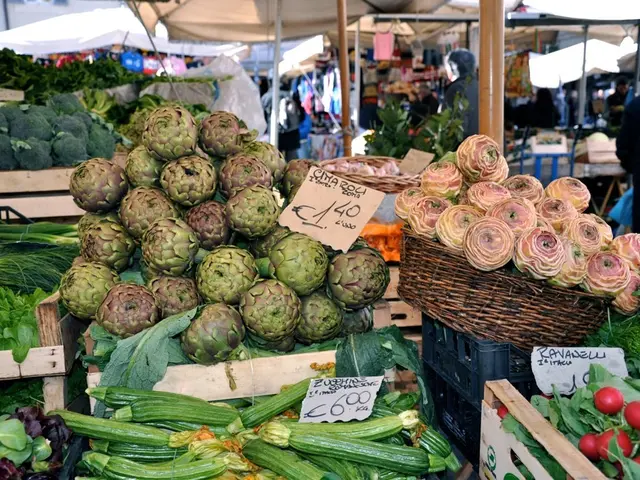Fresh Hop Agricultural Shift Reshaping the Brewing Sector: Insights into Innovative Harvesting Methods Revolutionizing Beer Production
Fresh Hop Farming Enhances the Beer Industry
Fresh hop farming, a long-standing tradition in the Yakima Valley of Washington State, continues to shape the beer industry in significant ways. At the heart of this revolution is Sauve and Son Farms, a family-owned farm that has been growing hops since 1938.
Under the leadership of Vice President, Erik Sauve, the farm grows 10 different hop varieties, both proprietary and public. These include Simcoe, Cascade, Amarillo, Citra, Mosaic, Columbus, Warrior, Ekuanot, HBC 682, and Idaho 7.
The unique aspect of fresh hop farming lies in its immediate use of the harvest. Fresh hops are mechanically harvested in the field using a top cutter and a picking machine, and due to their quick degradation, they are typically picked up by breweries and used immediately. This direct collaboration between farmers and brewers has led to stronger relationships, as brewers often pick up fresh hops directly from the farm.
Fresh hop beers, particularly Fresh hop IPAs, are the most popular in Washington State. These brews offer a burst of vibrant, complex, and juicy flavors with tropical fruit, citrus, and other bold notes. The fresh hop character is often described as bold, juicy, and aromatic, creating distinctive, regionally inspired beers.
However, using fresh hops requires roughly three times the amount of hops compared to pellets due to their green material absorbing wort. Despite this, the fresh hop experience is worth the investment for many breweries, as it enhances the beer's flavor profile and supports local agriculture.
Fresh hops can be any hop variety grown, with aroma hops being mostly requested. They can be received from any hop farm currently in harvest. After harvest, the hop bines are transported to the picking machine for separation of cones, leaves, and stems. The cones are sent to the kiln facility for drying, while leaves and stems are sent to a compost pile.
The practice of fresh hop farming has several notable effects on the beer industry. It enhances freshness and flavor quality, supports local agriculture and sustainability, fosters seasonal and regional identity, encourages innovation in beer styles and production, and promotes environmental and regenerative farming practices.
In summary, fresh hop farming enriches beer quality with fresher, more varied flavors while driving sustainability, local economic benefits, and innovative product offerings in the beer industry. Sauve and Son Farms, located in Mabton, Washington State, is a key player in this revolution, contributing to the vibrant craft brewing scene in the region.
[1] Fresh Hop Farming: A Boon for Craft Brewing. (2021). The Brewers Association. Retrieved from https://www.brewersassociation.org/-/media/files/learn/advocacy/fresh-hop-farming-a-boon-for-craft-brewing.pdf
[2] The Impact of Fresh Hop Farming on the Beer Industry. (2020). The Hop Growers of America. Retrieved from https://www.hopgrowers.org/wp-content/uploads/2020/09/The-Impact-of-Fresh-Hop-Farming-on-the-Beer-Industry.pdf
[3] The Rise of Hop Water: A Non-Alcoholic Beverage Trend. (2021). Beverage Industry Insights. Retrieved from https://www.beverageindustryinsights.com/the-rise-of-hop-water-a-non-alcoholic-beverage-trend/
[4] Regenerative Agriculture in Hop Farming: Sustainable Practices for a Green Future. (2020). The Hop Growers of America. Retrieved from https://www.hopgrowers.org/wp-content/uploads/2020/09/Regenerative-Agriculture-in-Hop-Farming-Sustainable-Practices-for-a-Green-Future.pdf
- The manufacturing industry of craft beer is being revitalized through fresh hop farming.
- Sauve and Son Farms, established in 1938, is a prominent family-owned farm contributing to this change.
- Erik Sauve, the farm's Vice President, oversees the growth of 10 diverse hop varieties.
- These hop varieties include Simcoe, Cascade, Amarillo, Citra, Mosaic, Columbus, Warrior, Ekuanot, HBC 682, and Idaho 7.
- Fresh hop farming is unique due to the immediate use of the harvest, leading to stronger relationships between farmers and brewers.
- Fresh hop beers, particularly Fresh hop IPAs, are popular in Washington State for their vibrant flavors with tropical fruit, citrus, and other bold notes.
- Using fresh hops requires more hops than pellets, but many breweries consider it a worthwhile investment for the enhanced flavor profile.
- Aroma hops are mostly requested in fresh hop farming, and they can be received from any farm currently in harvest.
- After harvest, hop bines are transported for cone separation, drying, and composting.
- Fresh hop farming improves beer quality, supports local agriculture, encourages innovation, and fosters seasonal and regional identity.
- The practice promotes sustainability, local economic benefits, and innovative product offerings in the beer industry.
- Fresh hop farming enriches the craft brewing scene, with Sauve and Son Farms being a key player in this movement.
- The Brewers Association and The Hop Growers of America have conducted research on the benefits of fresh hop farming.
- Another trend in the beer industry is the rise of Hop Water, a non-alcoholic beverage alternative.
- Regenerative agriculture practices are also being adopted in hop farming for a greener future.
- Entrepreneurship in the beer industry is thriving, with numerous small businesses emerging as craft breweries.
- Interior design, cooking, and even outdoor living can be influenced by the lifestyle associated with craft beer.
- The automotive industry can benefit from the growing demand for craft breweries, with increased transportation needs.
- Leadership skills are essential for farmers and brewers navigating this dynamic industry.
- Diversity and inclusion are important for fostering a welcoming and innovative environment in the beer industry.
- Wearables, smart home devices, and cybersecurity solutions can help breweries streamline production and reach customers.
- Lifestyle brands and retail outlets are increasingly incorporating craft beer into their offerings.
- The food and drink industry as a whole is influenced by the rise of craft beer, with dining experiences often featuring craft beers on their menus.
- Family dynamics can be influenced by the shared experience of brewing and enjoying craft beer.
- The automotive industry plays a role in transportation of ingredients and finished products for craft breweries.
- Small businesses, including craft breweries, are impacted by personal finance, wealth management, real estate, and the housing market.
- Investing in craft breweries and related industries can be considered by venture capitalists and private equity firms.
- Smartphones, gadgets, data, and cloud computing have become essential tools for managing and promoting craft breweries, reflecting the broader influence of technology on various industries.








